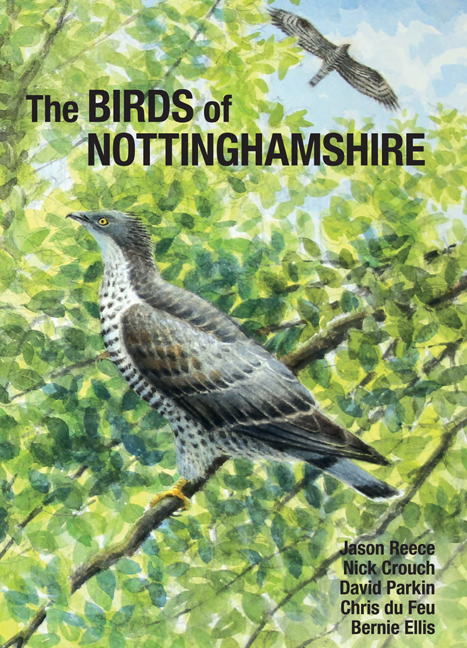Book contents
- Frontmatter
- Contents
- Foreword
- Acknowledgements
- Species sponsorship
- Introduction
- A history of bird recording in Nottinghamshire
- A description of Nottinghamshire and its bird habitats
- Methods
- Species accounts
- Additional Records 2014–2018
- Appendix: Additional and contentious species
- References
- Index
- Miscellaneous Endmatter
A description of Nottinghamshire and its bird habitats
- Frontmatter
- Contents
- Foreword
- Acknowledgements
- Species sponsorship
- Introduction
- A history of bird recording in Nottinghamshire
- A description of Nottinghamshire and its bird habitats
- Methods
- Species accounts
- Additional Records 2014–2018
- Appendix: Additional and contentious species
- References
- Index
- Miscellaneous Endmatter
Summary
Introduction
Nottinghamshire is a county in the English Midlands, covering some 216,157 ha (835 square miles). Longer than it is wide, and measuring around 73 km north to south and 43 km east to west, its shape was described by Whitaker (1907) as being similar to that of a ‘sandgrouse's egg’. Ours is a lowland county, dominated by farmland, with a human population of 1,147,100 (mid 2017 estimate). The main urban areas are Greater Nottingham in the south, Mansfield, Sutton-in-Ashfield and Kirkby-in-Ashfield in the west, Worksop and Retford in the north, Newark in the east, and Ollerton and Southwell in the centre. The county supports a range of lowland habitats, which are a product of interactions between the underlying geology, overlying hydrology, climate, and human activities.
National Character Areas (NCAs) are a useful starting point for providing a general description of the county. These are areas identified by Natural England that share similar landscape characteristics, and which follow natural lines in the landscape rather than administrative boundaries. Seven NCAs cover Nottinghamshire in substantial part, as shown in Figure 1.
The Nottinghamshire, Derbyshire and Yorkshire Coalfield (NCA 38) is a landscape of rolling ridges and escarpments, with a varied pattern of pastoral and mixed farming, former coal-mining areas (restored pit tips and opencast workings), and urban development, which includes Kimberley and Eastwood, the western suburbs of Nottingham, as well as smaller settlements. Fragmented semi-natural habitats are dispersed through the area, and include woodlands, grassland, and wetlands, the latter particularly associated with the Erewash valley.
The Southern Magnesian Limestone (NCA 30) is an elevated ridge with a rolling landform, with intensively farmed arable land, well-wooded estates and designed parklands. Semi-natural habitats, influenced by the underlying geology, include calcareous grasslands. A legacy of coal mining is prevalent, with restored colliery pit tips throughout the NCA. The southern part contains the major population centres of Hucknall, Annesley Woodhouse, Kirkby-in-Ashfield, and Sutton-in-Ashfield; the northern part is more rural, and includes the large villages of Carlton-in-Lindrick and Langold.
Sherwood (NCA 49) is a gently rolling, well-wooded landscape with a mosaic of broad-leaved, mixed and coniferous woodlands and arable farmland, whilst large country houses with parklands and lakes are a particular feature, as are colliery pit tips, either re-vegetated or undergoing restoration.
- Type
- Chapter
- Information
- The Birds of Nottinghamshire , pp. 21 - 48Publisher: Liverpool University PressPrint publication year: 2019

